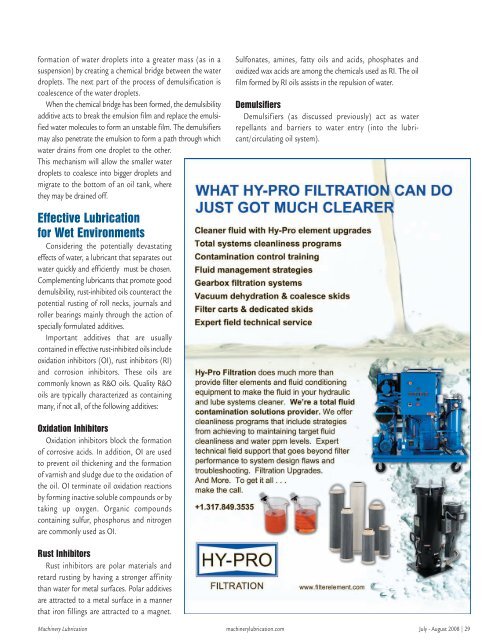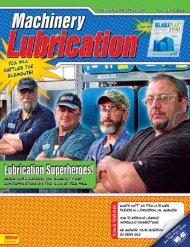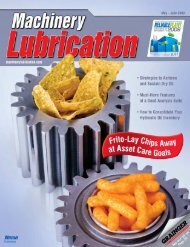Machinery Lubrication July August 2008
Machinery Lubrication July August 2008
Machinery Lubrication July August 2008
You also want an ePaper? Increase the reach of your titles
YUMPU automatically turns print PDFs into web optimized ePapers that Google loves.
formation of water droplets into a greater mass (as in a<br />
suspension) by creating a chemical bridge between the water<br />
droplets. The next part of the process of demulsification is<br />
coalescence of the water droplets.<br />
When the chemical bridge has been formed, the demulsibility<br />
additive acts to break the emulsion film and replace the emulsified<br />
water molecules to form an unstable film. The demulsifiers<br />
may also penetrate the emulsion to form a path through which<br />
water drains from one droplet to the other.<br />
This mechanism will allow the smaller water<br />
droplets to coalesce into bigger droplets and<br />
migrate to the bottom of an oil tank, where<br />
they may be drained off.<br />
Sulfonates, amines, fatty oils and acids, phosphates and<br />
oxidized wax acids are among the chemicals used as RI. The oil<br />
film formed by RI oils assists in the repulsion of water.<br />
Demulsifiers<br />
Demulsifiers (as discussed previously) act as water<br />
repellants and barriers to water entry (into the lubricant/circulating<br />
oil system).<br />
Effective <strong>Lubrication</strong><br />
for Wet Environments<br />
Considering the potentially devastating<br />
effects of water, a lubricant that separates out<br />
water quickly and efficiently must be chosen.<br />
Complementing lubricants that promote good<br />
demulsibility, rust-inhibited oils counteract the<br />
potential rusting of roll necks, journals and<br />
roller bearings mainly through the action of<br />
specially formulated additives.<br />
Important additives that are usually<br />
contained in effective rust-inhibited oils include<br />
oxidation inhibitors (OI), rust inhibitors (RI)<br />
and corrosion inhibitors. These oils are<br />
commonly known as R&O oils. Quality R&O<br />
oils are typically characterized as containing<br />
many, if not all, of the following additives:<br />
Oxidation Inhibitors<br />
Oxidation inhibitors block the formation<br />
of corrosive acids. In addition, OI are used<br />
to prevent oil thickening and the formation<br />
of varnish and sludge due to the oxidation of<br />
the oil. OI terminate oil oxidation reactions<br />
by forming inactive soluble compounds or by<br />
taking up oxygen. Organic compounds<br />
containing sulfur, phosphorus and nitrogen<br />
are commonly used as OI.<br />
Rust Inhibitors<br />
Rust inhibitors are polar materials and<br />
retard rusting by having a stronger affinity<br />
than water for metal surfaces. Polar additives<br />
are attracted to a metal surface in a manner<br />
that iron fillings are attracted to a magnet.<br />
<strong>Machinery</strong> <strong>Lubrication</strong> machinerylubrication.com <strong>July</strong> - <strong>August</strong> <strong>2008</strong> 29
















